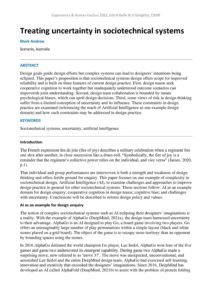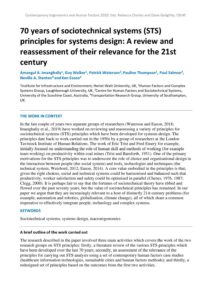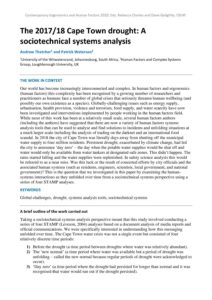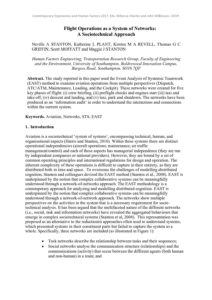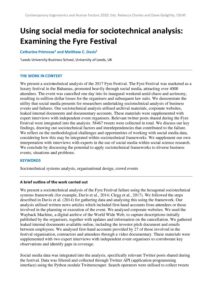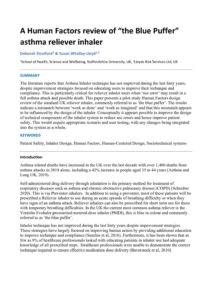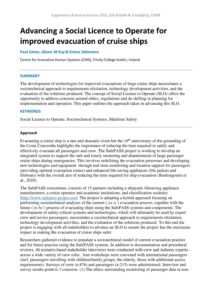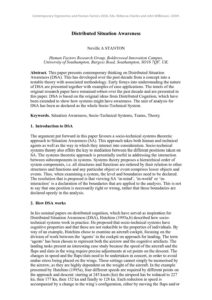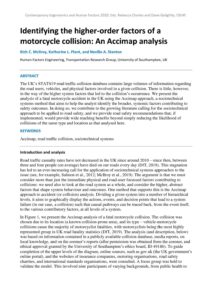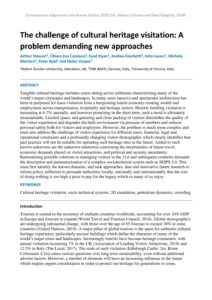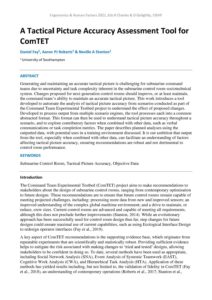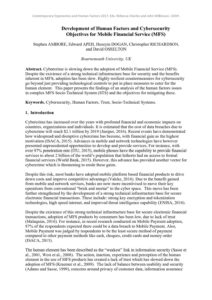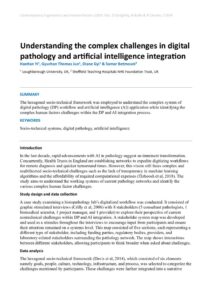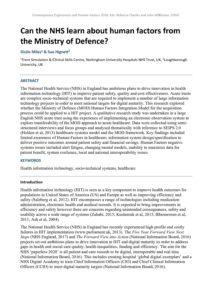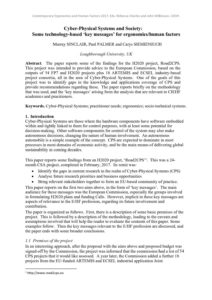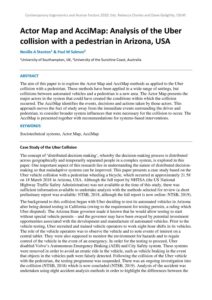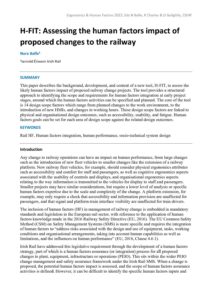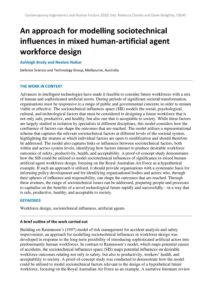Sociotechnical systems
Treating uncertainty in sociotechnical systems
| Document | Author Mark Andrew |
| Abstract Design goals guide design efforts but complex systems can lead to designers’ intentions being eclipsed. This paper’s proposition is that sociotechnical systems design offers scope for improved reliability and is built on three features of current design practice. First, design teams seek cooperative cognition to work together but inadequately understood outcome scenarios can impoverish joint understanding. Second, design team collaboration is bounded by innate psychological biases, which can spoil design decisions. Third, some views of risk in design thinking suffer from a limited conception of uncertainty and its influence. These constraints in design practice are examined (referencing the reach of Artificial Intelligence as one example design domain) and how such constraints may be addressed in design practice. |
70 years of sociotechnical systems (STS) principles for systems design: A review and reassessment of their relevance for the 21st century
| Document | Author Amangul A. Imanghaliy, Guy Walker, Patrick Waterson, Pauline Thompson, Paul Salmon, Neville A. Stanton and Ken Eason |
| Abstract In the last couple of years two separate groups of researchers (Waterson and Eason, 2018; Imanghaliy et al., 2019) have worked on reviewing and reassessing a variety of principles for sociotechnical systems (STS) principles which have been developed for systems design. The principles date back to work carried out in the 1950s by a group of researchers at the London Tavistock Institute of Human Relations. The work of Eric Trist and Fred Emery for example, initially focused on understanding the role of human skill and methods of working (for example team working) on productivity within coal mines (Trist and Bamforth, 1951). One of the primary motivations for the STS principles was to underscore the role of choice and organisational design in the interaction between people (the social system) and tools, technologies and techniques (the technical system; Weisbord, 2012; Eason, 2014). A core value embodied in the principles is that, given the right choices, social and technical systems could be harmonised and balanced such that productivity, worker satisfaction and safety could be optimised in parallel (Cherns, 1976, 1987; Clegg, 2000). It is perhaps fair to say that the fortunes of sociotechnical theory have ebbed and flowed over the past seventy years, but the value of sociotechnical principles has remained. In our paper we argue that they are increasingly relevant to a host of distinctly 21st century problems (for example, automation and robotics, globalisation, climate change), all of which share a common imperative to effectively integrate people, technology and complex systems. |
The 2017/18 Cape Town drought: A sociotechnical systems analysis
| Document | Author Andrew Thatcher and Patrick Waterson |
| Abstract Our world has become increasingly interconnected and complex. In human factors and ergonomics (human factors) this complexity has been recognised by a growing number of researchers and practitioners as humans face a number of global crises that seriously threaten human wellbeing (and possibly our own existence as a species). Globally-challenging issues such as energy supply, urbanisation, health provision, violence and terrorism, food supply, and water scarcity have now been investigated and interventions implemented by people working in the human factors field. While most of this work has been at a relatively small scale, several human factors authors (including the authors) have suggested that there are now a variety of human factors systems analysis tools that can be used to analyse and find solutions to incidents and unfolding situations at a much larger scale including the analysis of trading on the darknet and an international food scandal. In 2018 the city of Cape Town was literally days away from shutting off the municipal water supply to four million residents. Persistent drought, exacerbated by climate change, had led the city to announce ‘day zero’ – the day when the potable water supplies would be shut off and water would only be available from water tankers at designated safe zones. This didn’t happen. The rains started falling and the water supplies were replenished. In safety science analysis this would be referred to as a near miss. Was this luck or the result of concerted efforts by city officials and the associated human systems (such as residents, engineers, scientists, local government, and national government)? This is the question that we investigated in this paper by examining the human-systems interactions as they unfolded over time from a sociotechnical systems perspective using a series of four STAMP analyses. |
Flight Operations as a System of Networks: A Sociotechnical Approach
| Document | Author Neville A STANTON, Katherine L PLANT, Kirsten M A REVELL, Thomas G C GRIFFIN, Scott MOFFATT and Maggie J STANTON |
| Abstract The study reported in this paper used the Event Analysis of Systemic Teamwork (EAST) method to examine aviation operations from multiple perspectives (Dispatch, ATC/ATM, Maintenance, Loading, and the Cockpit). These networks were created for five key phases of flight: (i) crew briefing, (ii) preflight checks and engines start (iii) taxi and take-off, (iv) descent and landing, and (v) taxi, park and shutdown. The networks have been produced as an ‘information audit’ in order to understand the interactions and connections within the current system. |
Using social media for sociotechnical analysis: Examining the Fyre Festival
| Document | Author Catherine Primrose and Matthew C. Davis |
| Abstract We present a sociotechnical analysis of the 2017 Fyre Festival. The Fyre Festival was marketed as a luxury festival in the Bahamas, promoted heavily through social media, attracting over 4000 attendees. The event was cancelled one day into its inaugural weekend amid chaos and acrimony, resulting in million-dollar losses for the organisers and subsequent law suits. We demonstrate the utility that social media presents for researchers undertaking sociotechnical analysis of business events and failures. Our sociotechnical analysis utilised archival materials, corporate websites, leaked internal documents and documentary accounts. These materials were supplemented with expert interviews with independent event organisers. Relevant twitter posts shared during the Fyre Festival were integrated into the analysis. 58467 tweets were collected in total. We discuss our key findings, drawing out sociotechnical factors and interdependencies that contributed to the failure. We reflect on the methodological challenges and opportunities of working with social media data, considering how this may be integrated within sociotechnical frameworks. We supplement our own interpretation with interviews with experts in the use of social media within social science research. We conclude by discussing the potential to apply sociotechnical frameworks to diverse business events, situations and problems. |
A Human Factors review of “the Blue Puffer” asthma reliever inhaler
| Document | Author Deborah Stratford & Susan Whalley-Lloyd |
| Abstract The literature reports that Asthma Inhaler technique has not improved during the last forty years, despite improvement strategies focused on educating users to improve their technique and compliance. This is particularly critical for reliever inhaler users when ‘use error’ may result in a full asthma attack and possible death. This paper presents a pilot study Human Factors design review of the standard UK reliever inhaler, commonly referred to as ‘the blue puffer’. The results indicate a mismatch between ‘work as done’ and ‘work as imagined’ and that this mismatch appears to be influenced by the design of the inhaler. Conceptually it appears possible to improve the design of technical components of the inhaler system to reduce use errors and hence improve patient safety. This would require appropriate scenario and user testing, with any changes being integrated into the system as a whole. |
Advancing a Social Licence to Operate for improved evacuation of cruise ships
| Document | Author Paul Liston, Alison M Kay & Emma Delemere |
| Abstract The development of technologies for improved evacuations of large cruise ships necessitates a sociotechnical approach to requirements elicitation, technology development activities, and the evaluation of the solutions produced. The concept of Social Licence to Operate (SLO) offers the opportunity to address concerns around ethics, regulations and de-skilling in planning for implementation and operation. This paper outlines the approach taken in advancing this SLO. |
Distributed Situation Awareness
| Document | Author Neville A STANTON |
| Abstract This paper presents contemporary thinking on Distributed Situation Awareness (DSA). This has developed over the past decade from a concept into a testable theory with associated methodology. Early forays into understanding the nature of DSA are presented together with examples of case applications. The tenets of the original research paper have remained robust over the past decade and are presented in this paper. DSA is based on the original ideas from Distributed Cognition, which have been extended to show how systems might have awareness. The unit of analysis for DSA has been as declared as the whole Socio-Technical System. |
Identifying the higher-order factors of a motorcycle collision: An Accimap analysis
| Document | Author Rich C. McIlroy, Katherine L. Plant and Neville A. Stanton |
| Abstract The UK’s STATS19 road traffic collision database contains large volumes of information regarding the road users, vehicles, and physical factors involved in a given collision. There is little, however, in the way of the higher system factors that led to the collision’s occurrence. We present the analysis of a fatal motorcycle accident in the UK using the Accimap approach, a sociotechnical systems method that aims to help the analyst identify the broader, systemic factors contributing to safety outcomes. In doing so, we contribute to the growing literature calling for the sociotechnical approach to be applied to road safety, and we provide road safety recommendations that, if implemented, would provide wide reaching benefits beyond simply reducing the likelihood of collisions of the same type and location as that analysed here. |
The challenge of cultural heritage visitation: A problem demanding new approaches
| Document | Author Arthur Stewart, Chiara Eva Catalano, Eyad Elyan, Andrea Giachetti, John Isaacs, Michela Mortara, Peter Reid and Helen Vosper |
| Abstract Tangible cultural heritage includes assets dating across millennia characterising many of the world’s major cityscapes and landscapes. In many cases massive and spectacular architecture has been re-purposed for mass-visitation from a burgeoning tourist economy creating wealth and employment across transportation, hospitality and heritage sectors. Historic building visitation is increasing at 6-7% annually, and however promising in the short term, such a trend is ultimately unsustainable. Limited space, and queueing and close packing of visitors diminishes the quality of the visitor experience and degrades the built environment via pressure of numbers and reduces personal safety both for visitors and employees. However, the problem is much more complex and must also address the challenge of visitor experience for different users, financial, legal and operational constraints and a profoundly changing visitor-demographic which clearly identifies that past practice will not be suitable for operating such heritage sites in the future. Added to such known unknowns are the unknown unknowns concerning the uncertainties of future travel, economic demands placed on visitor attractions, and political and security uncertainty. Rationalising possible solutions to managing visitors in the 21st and subsequent centuries demands the description and parameterisation of a complex-sociotechnical system such as SEIPS 2.0. This must first identify the known domains, and seek approaches, data and innovative future research to inform policy sufficient to persuade authorities locally, nationally and internationally that the cost of doing nothing is too high a price to pay for the legacy which so many of us enjoy. |
A Tactical Picture Accuracy Assessment Tool for ComTET
| Document | Author Daniel Fay, Aaron PJ Roberts & Neville A Stanton |
| Abstract Generating and maintaining an accurate tactical picture is challenging for submarine command teams due to uncertainty and task complexity inherent in the submarine control room sociotechnical system. Changes proposed for next-generation control rooms should improve, or at least maintain, the command team’s ability to maintain an accurate tactical picture. This work introduces a tool developed to automate the analysis of tactical picture accuracy from scenarios conducted as part of the Command Team Experimental Testbed project to understand the effect of proposed changes. Developed to process output from multiple scenario engines, the tool processes each into a common abstracted format. This format can then be used to understand tactical picture accuracy throughout a scenario, and to explore contributory factors when combined with other data, such as verbal communications or task completion metrics. The paper describes planned analyses using the outputted data, with potential uses in a training environment discussed. It is our ambition that output from the tool, especially when combined with other data, can facilitate an understanding of factors affecting tactical picture accuracy, ensuring recommendations are robust and not detrimental to control room performance. |
Development of Human Factors and Cybersecurity Objectives for Mobile Financial Service (MFS)
| Document | Author Stephen AMBORE, Edward APEH, Huseyin DOGAN, Christopher RICHARDSON, and David OSSELTON |
| Abstract Cybercrime is slowing down the adoption of Mobile Financial Service (MFS). Despite the existence of a strong technical infrastructure base for security and the benefits inherent in MFS, adoption has been slow. Highly resilient countermeasures for cybersecurity go beyond just providing technological controls to put in place measures to cater for the human element. This paper presents the findings of an analysis of the human factors issues in complex MFS Socio-Technical System (STS) and the objectives for mitigating these. |
Understanding the complex challenges in digital pathology and artificial intelligence integration
| Document | Author Haotian Yi, Gyuchan Thomas Jun, Diane Gyi & Samar Betmouni |
| Abstract The hexagonal socio-technical framework was employed to understand the complex system of digital pathology (DP) workflow and artificial intelligence (AI) application while identifying the complex human factors challenges within the DP and AI integration process. |
Can the NHS learn about human factors from the Ministry of Defence?
| Document | Author Giulia Miles & Sue Hignett |
| Abstract The National Health Service (NHS) in England has ambitious plans to drive innovation in health information technology (HIT) to improve patient safety, quality and cost effectiveness. Acute trusts are complex socio-technical systems that are required to implement a number of large information technology projects in order to meet national targets for digital maturity. This research explored whether the Ministry of Defence (MOD) Human Factors Integration Model for the acquisition process could be applied to a HIT project. A qualitative research study was undertaken in a large English NHS acute trust using the experience of implementing an electronic observation system to explore transferability of the MOD approach to acute healthcare. Data were collected using semi-structured interviews and focus groups and analysed thematically with reference to SEIPS 2.0 (Holden et al, 2013) healthcare systems model and the MOD framework. Key findings included limited awareness of Human Factors in healthcare; information system design/specification to deliver positive outcomes around patient safety and financial savings. Human Factors negative systems issues included alert fatigue, changing mental models, inability to maximise data for patient benefit, system resilience, local and national interoperability issues. |
Cyber-Physical Systems and Society: Some technology-based ‘key messages’ for ergonomics/human factors
| Document | Author Murray SINCLAIR, Paul PALMER and Carys SIEMIENIUCH |
| Abstract The paper reports some of the findings for the H2020 project, Road2CPS. This project was intended to provide advice to the European Commission, based on the outputs of 54 FP7 and H2020 projects plus 18 ARTEMIS and ECSEL industry-based project consortia, all in the area of Cyber-Physical Systems. One of the goals of this project was to identify gaps in the knowledge and applications coverage of CPS and provide recommendations regarding these. The paper reports briefly on the methodology that was used, and the ‘key messages’ arising from the analysis that are relevant to CIEHF academics and pracitioners. |
Actor Map and AcciMap: Analysis of the Uber collision with a pedestrian in Arizona, USA
| Document | Author Neville A. Stanton & Paul M. Salmon |
| Abstract The aim of this paper is to explore the Actor Map and AcciMap methods as applied to the Uber collision with a pedestrian. These methods have been applied in a wide range of settings, but collisions between automated vehicles and a pedestrian is a new area. The Actor Map presents the major actors in the system that could have created the conditions within which the collision occurred. The AcciMap identifies the events, decisions and actions taken by those actors. This approach moves the foci of study away from the immediate events surrounding the driver and pedestrian, to consider broader system influences that were necessary for the collision to occur. The AcciMap is presented together with recommendations for systems-based interventions. |
H-FIT: Assessing the human factors impact of proposed changes to the railway
| Document | Author Nora Balfe |
| Abstract This paper describes the background, development, and content of a new tool, H-FIT, to assess the likely human factors impact of proposed railway change projects. The tool provides a structured approach to identifying the scope and requirements for human factors integration at early project stages, around which the human factors activities can be specified and planned. The core of the tool is 14 design scope factors which range from planned changes to the work environment, to the introduction of new HMIs, and changes in working hours. These design scope factors are linked to physical and organisational design outcomes, such as accessibility, usability, and fatigue. Human factors goals can be set for each area of design scope against the related design outcomes. |
An approach for modelling sociotechnical influences in mixed human-artificial agent workforce design
| Document | Author Ashleigh Brady and Neelam Naikar |
| Abstract Advances in intelligent technologies have made it feasible to consider future workforces with a mix of human and sophisticated artificial actors. During periods of significant societal transformation, organisations must be responsive to a range of public and governmental concerns in order to remain viable or effective. The sociotechnical influences space (SIS) models the social, psychological, cultural, and technological factors that must be considered in designing a future workforce that is not only safe, productive, and healthy, but also one that is acceptable to society. While these factors are largely studied in isolation by specialists in different disciplines, this model considers how the confluence of factors can shape the outcomes that are reached. The model utilises a representational scheme that captures the relevant sociotechnical factors at different levels of the societal system, highlighting the stratum at which individual factors are open to modification and should therefore be addressed. The model also captures links or influences between sociotechnical factors, both within and across system levels, identifying how factors interact to produce desirable workforce outcomes of safety, productivity, health, and acceptability. A proof-of-concept study demonstrates how the SIS could be utilised to model sociotechnical influences of significance in mixed human-artificial agent workforce design, focusing on the Royal Australian Air Force as a hypothetical example. If such an approach is utilised, it should provide organisations with a systematic basis for informing policy development and for identifying organisational bodies and actors who, through their spheres of influence and responsibility, can shape the outcomes that are reached. Through these avenues, the range of sociotechnical issues can be addressed, preparing people and processes to capitalise on the benefits of a novel technological future rapidly and successfully—in a way that is safe, productive, healthy, and acceptable to society. |
Using the decision ladder to reach a better design
| Document | Author Daniel P. JENKINS, Malcolm BOYD, Chris LANGLEY |
| Abstract As with all safely critical interfaces, it is imperative that medical devices communicate the right information, to the right people, at the right time, in the right place, and in an optimal format. This paper describes an approach for eliciting information requirements based on Rasmussen’s decision ladder. A hypothetical example of radiography equipment is used to illustrate the process; however, the approach is also considered to be applicable to a wide range of domains. The approach is based on a semi-structured interview and creates an explicit link between the data collection activity and the final design interface. |

